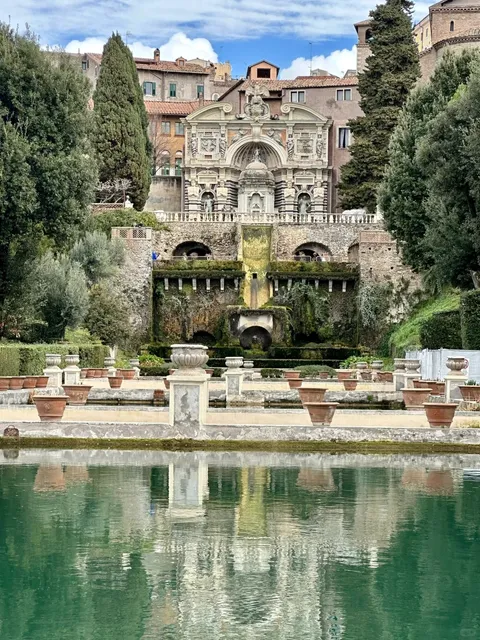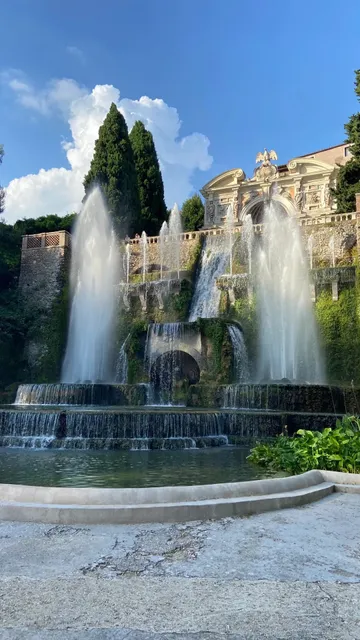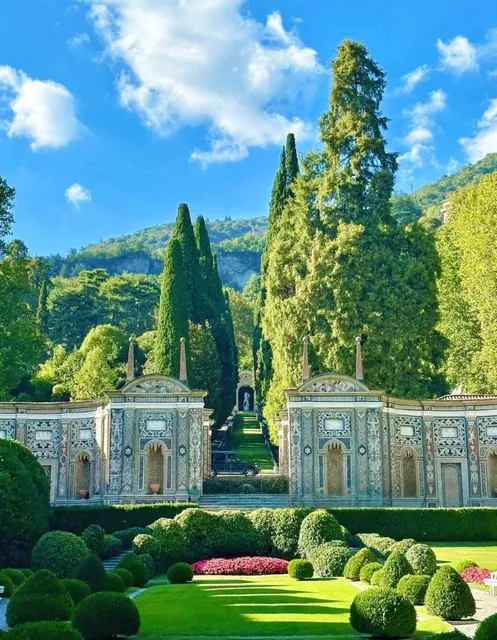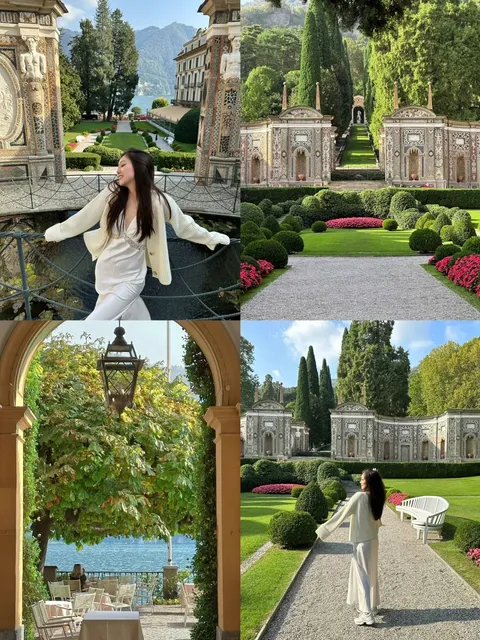Villa d’Este is a magnificent Renaissance villa located in Tivoli, Italy, about 30 kilometers from Rome. Famous for its terraced hillside garden and spectacular fountains, it is considered one of the most important examples of Renaissance architecture and garden design in Europe. The villa was built in the 16th century for Cardinal Ippolito II d’Este, a member of the prominent d’Este family, and is now a UNESCO World Heritage site.
History:
The creation of Villa d’Este began in 1550 when Ippolito II d’Este, a cardinal and son of Lucrezia Borgia, was appointed Governor of Tivoli. He commissioned Pirro Ligorio, an architect and painter, to design both the villa and its expansive gardens. The villa was intended to reflect the power, prestige, and cultural sophistication of the d’Este family.
Despite its splendor, the construction and design were not completed until after the Cardinal’s death in 1572. Over the centuries, the villa changed ownership several times, underwent periods of neglect, and experienced restoration efforts that preserved its beauty.
Architecture and Design:
The villa’s architecture is a grand reflection of Renaissance ideals, characterized by its symmetry, harmony, and elegance. The interior of the villa is adorned with frescoes, stuccoes, and intricate decorative elements, created by leading artists of the time. These frescoes depict scenes from mythology, history, and the arts, making the interior spaces just as impressive as the famous gardens.
The Gardens:
The true highlight of Villa d’Este is its extensive and elaborate garden, which cascades down a steep hillside. Designed in the Italian Renaissance garden style, the gardens are laid out on multiple terraces connected by staircases and paths. They are renowned for their ingenious use of water, with over 500 fountains, pools, waterfalls, and grottoes.
• Fountain of Neptune: One of the most iconic features of the garden, this fountain was remodeled in the 20th century and features a central cascade flanked by powerful jets of water. • Hundred Fountains: A long, linear water feature with a row of small fountains, this walkway is one of the most photographed parts of the garden. The water flows through a series of spouts shaped like animals and mythical creatures. • Fountain of the Organ: This fountain is remarkable not only for its beauty but also for its musical component. It originally played music through the movement of water, recreating the sounds of an organ, a feature restored in modern times.
The design of the garden is heavily influenced by classical Roman and Renaissance themes, with statues, mythological references, and architectural elements integrated into the landscape.
Cultural and Historical Significance:
Villa d’Este’s design reflects the Renaissance ideals of humanism, where art, nature, and architecture are harmoniously blended. The garden’s symbolic references to ancient Rome, combined with its technological innovations in water engineering, made it a model for later garden designs in Europe. The villa’s influence can be seen in the gardens of Versailles in France and other European palaces.
In addition to its architectural and horticultural significance, Villa d’Este has inspired many artists, poets, and musicians over the centuries. Composer Franz Liszt famously stayed at the villa and wrote Les Jeux d’Eau à la Villa d’Este, a piano piece inspired by the sound of its fountains.
UNESCO World Heritage Status:
In 2001, Villa d’Este was inscribed as a UNESCO World Heritage Site due to its historical significance and outstanding representation of Renaissance art and garden design. UNESCO recognizes the villa as a masterpiece of human creative genius, blending architecture, water, and landscape in a way that has influenced the development of gardens...
Read moreOutstanding Universal Value Brief synthesis
The palace and the gardens of Villa d’Este in Tivoli, in the centre of Italy, were laid out by Pirro Ligorio (1500-1583) on behalf of Cardinal Ippolito II d’Este of Ferrara (1509-1572), who, after being named governor of Tivoli in 1550, desired the realization of a palace adequate to his new status. The ensemble composed of the palace and gardens forms an uneven quadrilateral and covers an area of about 4.5 ha.
The Villa d’Este in Tivoli is one of the most remarkable and comprehensive illustrations of Renaissance culture at its most refined. Owing to its innovative design and the creativity and ingenuity of the architectural components in the gardens (fountains, ornamental basins, etc.), it is a true water garden and a unique example of an Italian 16th century garden. The Villa d’Este, one of the first giardini delle meraviglie, served as a model for and had a decisive influence on the development of gardens in Europe.
The plan of the villa is irregular because the architect was obliged to make use of certain parts of the previous monastic building. On the gardens’ side, the architecture of the palace is very simple: a long main body of three storeys, marked by bands, rows of windows, and side pavilions that barely jut out. This uniform facade is interrupted by an elegant loggia in the middle, with two levels and stair ramps. Starting in 1560 great efforts were made to supply the water needed for the numerous fountains that were intended to embellish the gardens. Once the water supply had been ensured and its flow made possible by the natural gravity created by the different levels of the garden, work started on constructing the fountains, ornamental basins, and grottoes and on laying out the landscape.
The Villa d’Este gardens stretch over two steep slopes, descending from the palace down to a flat terrace in the manner of an amphitheatre. The loggia of the palace marks the longitudinal and central axis of the gardens. Five main transversal axes become the central axis from the fixed point of view created by the villa, as each of these axes terminates in one of the gardens’ fountains. This arrangement of axes and modules was adopted to disguise the irregular outline of the gardens, to rectify by means of an optical illusion the relationship between the transversal and longitudinal dimensions, and to give the palace a central position, even though it is in fact out of alignment in relation to the whole.
The most striking effect is produced by the big cascade flowing out of a krater perched in the middle of the exedra. Jets of water were activated whenever unsuspecting people walked under the arcades. The Fontana del Bicchierone (Fountain of the Great Glass), built according to a design by Bernini (1660-61) was added to the decoration of the central longitudinal axis in the 17th century. This fountain is in the shape of a serrated chalice, from which a high jet of water falls into a conch shell. The gardens with the fountains, is a masterpiece of hydraulic engineering, both for the general layout of the plan and the complex system of distribution of water as well as for the many water plays with the introduction of the first hydraulic...
Read moreI knew nothing about this spot, so, naturally, I did a bunch of research to write a Sara-take on this spot. Thesis coming right up. You’re welcome Jensen W.
You ever walk into a place and immediately think, Okay, calm down? That’s Villa d’Este. In the hills of the adorable town of Tivoli, this place is a full-blown Renaissance fever dream. There are intricately carved fountains everywhere, 500-year-old frescoes on literally every surface, and gardens that look like they were landscaped by the gods on their day off. It’s not a villa, it’s a humblebrag in stone and water decorated by mature flowers. Peep that wisteria.
The villa was the brainchild of Cardinal Ippolito II d’Este, who clearly decided that if he couldn’t be Pope, he’d settle for becoming the main character in Italian architecture. Find your niche bro, I understand. So, in true Borgia-adjacent fashion (yes, Lucrezia was his mom, no big deal), he hijacked an old Benedictine monastery, brought in artists, engineers, and whatever 16th-century version of an influencer was available, and built himself a Renaissance Crash Pad.
Let’s talk about the inside first. The frescoes specifically. Oh, you mean the walls and ceilings casually coated in art that’s older than most countries? Yeah, those. Still vibrant, still dramatic, still making you feel underdressed. Clean it up, you peasant. You could spend hours just spinning in a circle trying to process all the mythical creatures, divine beings, and symbolic flexes Ippolito had slapped onto every surface. And the craziest part of all? This all somehow survived World War II. I don’t know who bribed the gods of war, but the fact that this place didn’t get bombed is wild. Divine intervention? Maybe. Or maybe even bombs were like…. Nah, too pretty.
And then there are the gardens. Ippolito clearly looked at nature and said, Let’s make it extra. Fountains are everywhere. The Fountain of Neptune straight up screams opulence. The Hundred Fountains? Literally a long wall of water just because they could. No electricity by the way. This is all gravity-fed engineering sorcery from the 1500s.
So yeah, Villa d’Este is kind of a diva. But when you’re 500 years old, survived wars, and still outshine modern garden designers, you’ve earned the right to be extra. It’s unapologetically over-the-top. And we’re lucky it’s still here...
Read more


